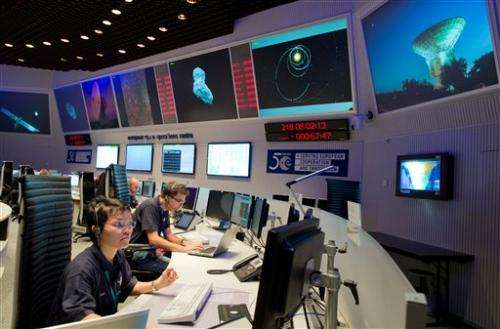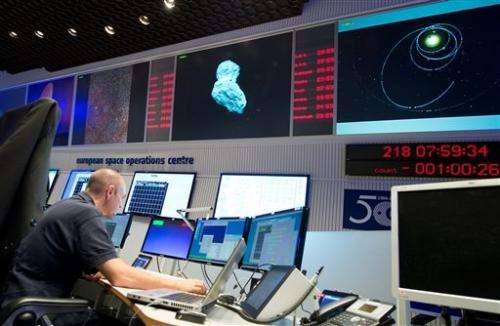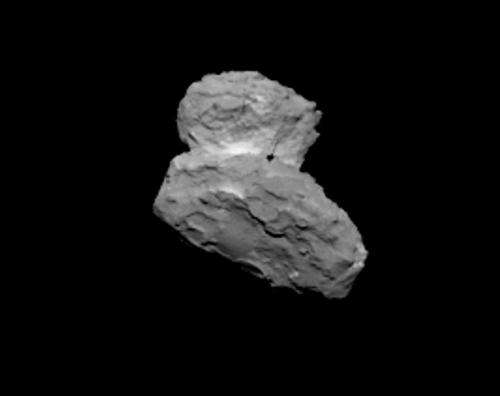Rosetta probe makes space history with rendezvous with comet (Update)

The space probe Rosetta on Wednesday made a historic rendezvous with a comet, climaxing a 10-year, six-billion-kilometre (3.7-billion-mile) chase through the Solar System, the European Space Agency (ESA) said.
"We're at the comet," Rosetta's flight operations manager, Sylvain Lodiot, declared in a webcast from mission control in Darmstadt, Germany.
It marks the first time a spacecraft has been sent into orbit around a comet, a wanderer of the Solar System whose primeval dust and ice may hold insights into how the planets formed.
In November, a robot scientific lab called Philae will be sent down to the surface to make the first-ever landing on a comet.
Rosetta's rendezvous with Comet 67P/Churyumov-Gerasimenko was confirmed at 0929 GMT at distance of 400 million km from Earth, according to signals received at ground stations.
ESA Director General Jean-Jacques Dordain hailed the fruit of 20 years' work to design, build and launch the three-tonne craft and then steer it to a tiny target in deep space.
"It makes 2014 the year of Rosetta," he said.
"Rosetta is a unique mission, unique by its scientific goal," Dordain said. "Understanding our origins is certainly the best way to understand our future."
On its Twitter page, the Rosetta mission said "Hello, comet!" in the languages of the agency's 20 nations.
"It's a historic meeting and a great first in world science, which the global space community has been awaiting for a decade," said Jean-Yves Le Gall, president of France's National Centre for Space Research (CNES), a major contributor to the project.
ESA showed a close-up picture of a gnarled, greyish object, comprising two lobes joined by a neck. The surface is pucked by what seems to be impact marks.

"Our first clear views of the comet have given us plenty to think about," project scientist Matt Taylor said.
"Is this double-lobed structure built from two separate comets that came together in the Solar System's history, or is it one comet that has eroded dramatically and asymmetrically over time?"
Launched in March 2004, Rosetta had to make four flybys of Mars and Earth, using their gravitational force as a slingshot to build up speed to catch up with its prey.
It entered a 31-month hibernation as light from the distant Sun became too weak for its solar panels. That period ended in January with a wake-up call sent from Earth.
It then began a complex series of manoeuvres to slow down to walking speed with the comet.
If any one of those operations had failed, the probe would have gone whizzing past its target.
The final manoeuvre was a small firing of thrusters, lasting just six minutes and 26 seconds, it said.
"This burn will tip Rosetta into the first leg of a series of three-legged triangular paths about the comet," ESA said.
The "pyramidal" track placed the craft at a height of about 100 kilometres (60 miles) above the comet, said Lodiot.
Each leg of the triangle will be around 100 kilometres and take Rosetta between three and four days to complete.
Rosetta will gradually reduce its height, entering gravitational orbit in September.

Primeval matter
Comets are believed by astrophysicists to be ancient ice and dust left from the building of the Solar System around 4.6 billion years ago. This cosmic rubble is the oldest, least touched material in our stellar neighbourhood.
Understanding its chemical ID and physical composition will give insights into how the planets coalesced after the Sun flared into light, it is hoped.
It could also determine the fate of a theory called "pan-spermia," which suggests comets, by smashing into the infant Earth, sowed our home with water and precious organic molecules, providing us with a kickstart for life.
The spacecraft is named after the famous stone, now in the British Museum, which explained Egyptian hieroglyphics, while its payload, Philae, is named after a Nile obelisk that in turn helped decipher the Rosetta stone.
The four-kilometre comet returns around the Sun on an egg-shaped orbit every six and a half years, its furthest point being beyond Jupiter.
It is named after two Ukrainian astronomers, Klim Churyumov and Svetlana Gerasimenko, who first spotted it in 1969.
Rosetta and Philae: Profile of comet-chasing team
Following is a profile of the Rosetta spacecraft, its payload Philae and the instruments they carry:
ROSETTA
The backbone of the Rosetta mission is a large unmanned spacecraft designed to orbit 67P/Comet Churyumov-Gerasimenko as it races through the Solar System and scans its icy head with an array of hi-tech eyes.
This orbiter, Rosetta, is a 2.9-tonne box measuring 2.8 x 2.1 x 2.0 metres (9.1 x 6.8 X 6.5 feet) with two vast solar arrays, 14 metres (45 feet) long, which have the surface area of a basketball court.
The panels comprise hundreds of thousands of non-reflective silicon cells, enabling Rosetta to suck power out of sunlight even when the Sun, hundreds of millions of kilometres (miles) away, is just a cold and tiny disc.
Also revolutionary, for the age in which it was launched, is Rosetta's decision-making power.
Instructions from Earth, even though they are travelling at the speed of light, take up to 50 minutes to reach the spacecraft depending on its position, so Rosetta is equipped with smart computers, with backups to provide it with the "intelligence" to look after itself.
Rosetta's 11 instruments will grab images of the comet in various parts of the energy spectrum, analyse the gases that gush from its nucleus as its icy surface is stripped away by the Sun, and a powerful radar whose echoes should give a cross-section of the comet's nucleus.
The instruments are:
- Ultraviolet Imaging Spectrometer (ALICE)
- Comet Nucleus Sounding (CONSERT)
- Cometary Secondary Ion Mass Analyser (COSIMA)
- Grain Impact Analyser and Dust Accumulator (GIADA)
- Micro-Imaging Analysis System (MIDAS)
- Microwave Instrument for the Rosetta Orbiter (MIRO)
- Rosetta Orbiter Imaging System (OSIRIS)
- Rosetta Orbiter Spectrometer for Ion and Neutral Analysis (ROSINA)
- Rosetta Plasma Consortium (RPC)
- Radio Science Investigation (RSI)
- Visible and Infrared Mapping Spectrometer (VIRTIS)
PHILAE
Rosetta's payload is a miniaturised laboratory called Philae, which will carry out the first landing on a comet, using an onboard chemistry set to get a precise view of the elements that make its icy, rocky surface.
The 100-kilo (220 pound) lander, due to be released on November 11, will have to make a feathery landing to avoid bouncing back and spinning uselessly into space, for comets have very low gravity.
As soon it makes contact, it will fire a small tethered harpoon into the comet's surface to gain an anchorage, and then extend its three legs, whose feet will also drill down a few centimetres (inches) to get a good hold.
The lander's impact on the comet should not cause any deviation in trajectory, given the huge differences in their respective masses.
Philae will use its 10 instruments to analyse the chemical, mineralogical and radioactive composition of the comet's surface and subsurface.
This "hands-on" data will be relayed back to the orbiter, Rosetta, which will then retransmit the information to Earth.
Philae's instruments, and their mission names, are as follows:
- Alpha Proton X-ray Spectrometer (APXS)
- Rosetta Lander Imaging System (CIVA/ROLIS)
- Comet Nucleus Sounding (CONSERT)
- Cometary Sampling and Composition experiment (COSAC)
- Evolved Gas Analyser (PTOLEMY)
- Multi-Purpose Sensor for Surface and Subsurface Science (MUPUS)
- Rosetta Lander Imaging System, ROLIS, designed to provide the first close-up images of the landing site)
- RoLand Magnetometer and Plasma Monitor (ROMAP)
- Sample Distribution Device (SD2)
- Surface Electrical and Acoustic Monitoring Experiment, Dust Impact Monitor (SESAME)
NAMES
- Rosetta is named after the famous stone in the British Museum that helped early 19th-century Egyptologists decipher hieroglyphics, the script of the Pharoahs.
- Philae is named after an obelisk on the Nile whose inscriptions were in turn a key to the Rosetta Stone.
- Comet 67P/Churyumov-Gerasimenko is named after two Ukrainian astronomers, Klim Churyumov and Svetlana Gerasimenko, who first spotted it in 1969. The "67P" refers to its position on the International Astronomical Union (IAU) list of periodic comets, meaning comets whose return past Earth is known. 1P is occupied by the famous Halley's Comet.
- Rosetta was initially scheduled to launch in January 2003, but the launch was delayed for 14 months. Its initial target, 46P/Wirtanen, was replaced by Comet "C-G."
© 2014 AFP




















